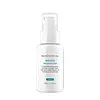What's inside
What's inside
 Key Ingredients
Key Ingredients

No key ingredients
 Benefits
Benefits

 Concerns
Concerns

 Ingredients Side-by-side
Ingredients Side-by-side

Water
Skin ConditioningSqualane
EmollientGlycerin
HumectantIsopropyl Lauroyl Sarcosinate
Skin ConditioningUndecane
EmollientButyrospermum Parkii Butter
Skin ConditioningTridecane
PerfumingPEG-100 Stearate
Glyceryl Stearate
EmollientPEG-20 Stearate
EmulsifyingAmmonium Polyacryloyldimethyl Taurate
Emulsion StabilisingBisabolol
MaskingButylene Glycol
HumectantCaffeine
Skin ConditioningCaprylyl Glycol
EmollientCarbomer
Emulsion StabilisingCetyl Alcohol
EmollientDextrin
AbsorbentDisodium EDTA
Eperua Falcata Bark Extract
Skin ProtectingFarnesol
PerfumingPalmitoyl Tripeptide-8
Skin ConditioningPanthenol
Skin ConditioningPentaerythrityl Tetra-Di-T-Butyl Hydroxyhydrocinnamate
AntioxidantSodium Benzoate
MaskingTocopherol
AntioxidantTriethanolamine
BufferingXanthan Gum
EmulsifyingZinc Gluconate
Skin ConditioningWater, Squalane, Glycerin, Isopropyl Lauroyl Sarcosinate, Undecane, Butyrospermum Parkii Butter, Tridecane, PEG-100 Stearate, Glyceryl Stearate, PEG-20 Stearate, Ammonium Polyacryloyldimethyl Taurate, Bisabolol, Butylene Glycol, Caffeine, Caprylyl Glycol, Carbomer, Cetyl Alcohol, Dextrin, Disodium EDTA, Eperua Falcata Bark Extract, Farnesol, Palmitoyl Tripeptide-8, Panthenol, Pentaerythrityl Tetra-Di-T-Butyl Hydroxyhydrocinnamate, Sodium Benzoate, Tocopherol, Triethanolamine, Xanthan Gum, Zinc Gluconate
Water
Skin ConditioningDimethicone
EmollientGlycerin
HumectantEthylhexyl Palmitate
EmollientButylene Glycol
HumectantCetyl PEG/PPG-10/1 Dimethicone
EmulsifyingPentaerythrityl Tetraethylhexanoate
EmollientC30-45 Alkyl Dimethicone
Skin ConditioningIsohexadecane
EmollientDipropylene Glycol
HumectantPEG/PPG-18/18 Dimethicone
EmulsifyingMagnesium Sulfate
Phenoxyethanol
PreservativeCaprylyl Glycol
EmollientDimethiconol
EmollientSodium Palmitoyl Proline
Skin ConditioningSodium Benzoate
MaskingCentella Asiatica Extract
CleansingSodium Carboxymethyl Beta-Glucan
CleansingCitric Acid
BufferingNymphaea Alba Flower Extract
Skin ConditioningWater, Dimethicone, Glycerin, Ethylhexyl Palmitate, Butylene Glycol, Cetyl PEG/PPG-10/1 Dimethicone, Pentaerythrityl Tetraethylhexanoate, C30-45 Alkyl Dimethicone, Isohexadecane, Dipropylene Glycol, PEG/PPG-18/18 Dimethicone, Magnesium Sulfate, Phenoxyethanol, Caprylyl Glycol, Dimethiconol, Sodium Palmitoyl Proline, Sodium Benzoate, Centella Asiatica Extract, Sodium Carboxymethyl Beta-Glucan, Citric Acid, Nymphaea Alba Flower Extract
 Reviews
Reviews

Ingredients Explained
These ingredients are found in both products.
Ingredients higher up in an ingredient list are typically present in a larger amount.
Butylene Glycol (or BG) is used within cosmetic products for a few different reasons:
Overall, Butylene Glycol is a safe and well-rounded ingredient that works well with other ingredients.
Though this ingredient works well with most skin types, some people with sensitive skin may experience a reaction such as allergic rashes, closed comedones, or itchiness.
Learn more about Butylene GlycolCaprylyl Glycol is a humectant and emollient, meaning it attracts and preserves moisture.
It is a common ingredient in many products, especially those designed to hydrate skin. The primary benefits are retaining moisture, skin softening, and promoting a healthy skin barrier.
Though Caprylyl Glycol is an alcohol derived from fatty acids, it is not the kind that can dry out skin.
This ingredient is also used as a preservative to extend the life of products. It has slight antimicrobial properties.
Learn more about Caprylyl GlycolGlycerin is already naturally found in your skin. It helps moisturize and protect your skin.
A study from 2016 found glycerin to be more effective as a humectant than AHAs and hyaluronic acid.
As a humectant, it helps the skin stay hydrated by pulling moisture to your skin. The low molecular weight of glycerin allows it to pull moisture into the deeper layers of your skin.
Hydrated skin improves your skin barrier; Your skin barrier helps protect against irritants and bacteria.
Glycerin has also been found to have antimicrobial and antiviral properties. Due to these properties, glycerin is often used in wound and burn treatments.
In cosmetics, glycerin is usually derived from plants such as soybean or palm. However, it can also be sourced from animals, such as tallow or animal fat.
This ingredient is organic, colorless, odorless, and non-toxic.
Glycerin is the name for this ingredient in American English. British English uses Glycerol/Glycerine.
Learn more about GlycerinSodium Benzoate is a preservative. It's used in both cosmetic and food products to inhibit the growth of mold and bacteria. It is typically produced synthetically.
Both the US FDA and EU Health Committee have approved the use of sodium benzoate. In the US, levels of 0.1% (of the total product) are allowed.
Sodium benzoate works as a preservative by inhibiting the growth of bacteria inside of cells. It prevents the cell from fermenting a type of sugar using an enzyme called phosphofructokinase.
It is the salt of benzoic acid. Foods containing sodium benzoate include soda, salad dressings, condiments, fruit juices, wines, and snack foods.
Studies for using ascorbic acid and sodium benzoate in cosmetics are lacking, especially in skincare routines with multiple steps.
We always recommend speaking with a professional, such as a dermatologist, if you have any concerns.
Learn more about Sodium BenzoateWater. It's the most common cosmetic ingredient of all. You'll usually see it at the top of ingredient lists, meaning that it makes up the largest part of the product.
So why is it so popular? Water most often acts as a solvent - this means that it helps dissolve other ingredients into the formulation.
You'll also recognize water as that liquid we all need to stay alive. If you see this, drink a glass of water. Stay hydrated!
Learn more about Water